10 Iconic Floral Still Lifes You Need to Know
Flowers have long been a central theme in still-life painting. Each flower carries its own symbolism. For example, they can represent innocence,...
Errika Gerakiti 6 February 2025
On April 26th, 1937 the world was shaken by the news of the destructive force that targeted Guernica – a town in the Basque Region of Spain, which fell victim to a brutal Spanish Civil War. The scale of the destruction and the unprecedented targeting of civilians broke the news in Western media, but it was art that ingrained Guernica’s story as one of the most vicious attacks of the 20th century.
Why was this event so shocking? It was the first time the air raid on such a large scale targeted civilians. The horror experienced by the victims was publicized by foreign war correspondents covering the Spanish Civil War.
“A Government official, tears streaming down his face, burst into the dismal dining-room crying: ‘Guernica is destroyed. The Germans bombed and bombed and bombed.’ The time was about 9.30 p.m. Captain Roberts banged a huge fist on the table and said: ‘Bloody swine.’ Five minutes later I was in one of Mendiguren’s limousines speeding towards Guernica. We were still a good ten miles away when I saw the reflection of Guernica’s flames in the sky. As we drew nearer, on both sides of the road, men, women, and children were sitting, dazed. I saw a priest in one group. I stopped the car and went up to him. ‘What I happened, Father?’ I asked. His face was blackened, his clothes in tatters. He couldn’t talk. He just pointed to the flames, still about four miles away, then whispered: ‘Aviones. . . bombas’. . . mucho, mucho“ – the words of Noel Monks, the first war correspondent to enter the city of Guernica, Spain, on 26th April 1937 (Noel Monks, Eyewitness, 1955).
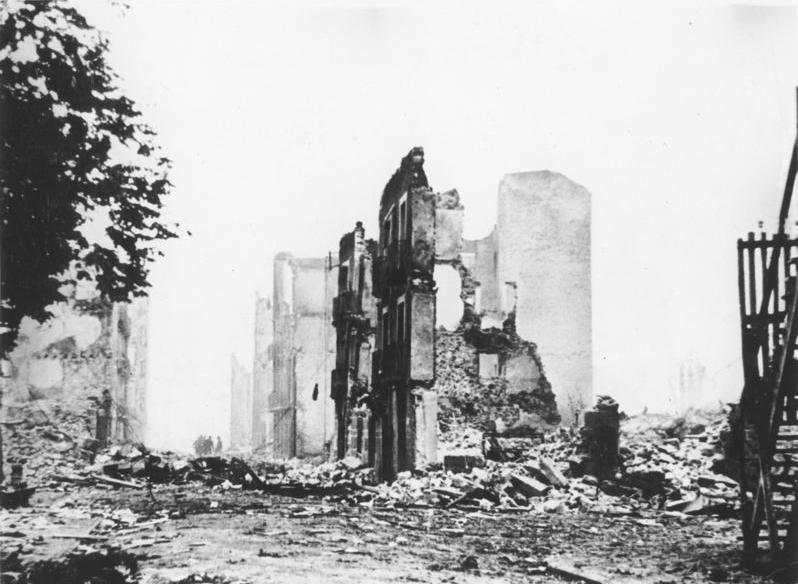
By targeting the innocent, the German bombers that attacked the small town that day marked a change in warfare. However, the event signaled a change in art too, enabling artists to connect with the suffering and to represent it in art.
In early 1937, Pablo Picasso had been commissioned to produce a work for the Spanish Pavilion for the upcoming World’s Fair in Paris. The goal of the commissioned piece was to raise awareness about the ongoing Spanish Civil War. Picasso had begun the work but the bombing in Guernica changed his focus. After reading about the atrocity, he set to work.
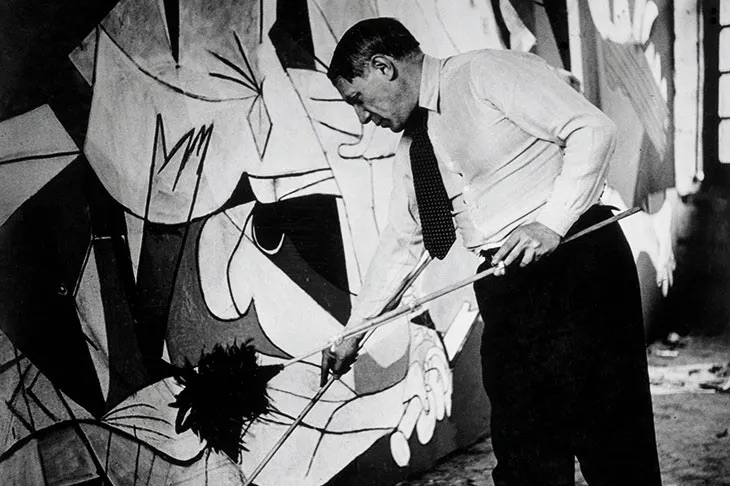















On a mural-sized painting, using a muted black, white, and grey palette, Picasso produced what is undeniably one of the most compelling antiwar canvas in history. While working on it he said, “The Spanish struggle is the fight of reaction against the people, against freedom. My whole life as an artist has been nothing more than a continuous struggle against reaction and the death of art. How could anybody think for a moment that I could be in agreement with reaction and death? … In the panel on which I am working, which I shall call Guernica, and in all my recent works of art, I clearly express my abhorrence of the military caste which has sunk Spain in an ocean of pain and death“ (Colm Tóibín, The Art of War, The Guardian, 29 April 2006).
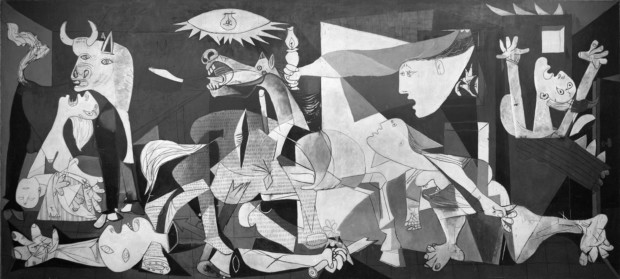















































The pain and anguish of the victims is palpable in this work. The mother holding her dead infant howls helplessly to the sky; her head pulled back to an almost inhuman position. The screams are mirrored in the man on the right, engulfed in flames. Bodies lie crumpled underneath the ruins in distorted angles.
Despite its size (3.49 m/11.45 ft tall and 7.76 m/25.46 ft across), you can imagine the speed at which Picasso worked at this. It was completed in just 35 days!
Picasso was not the only artist to be affected by the atrocity. Philip Guston, born in Montreal, of Ukrainian Jewish parents and raised in Los Angeles, had recently been in Mexico working with another artist, Reuben Kadish on an anti-fascist mural: The Struggle Against Terrorism.
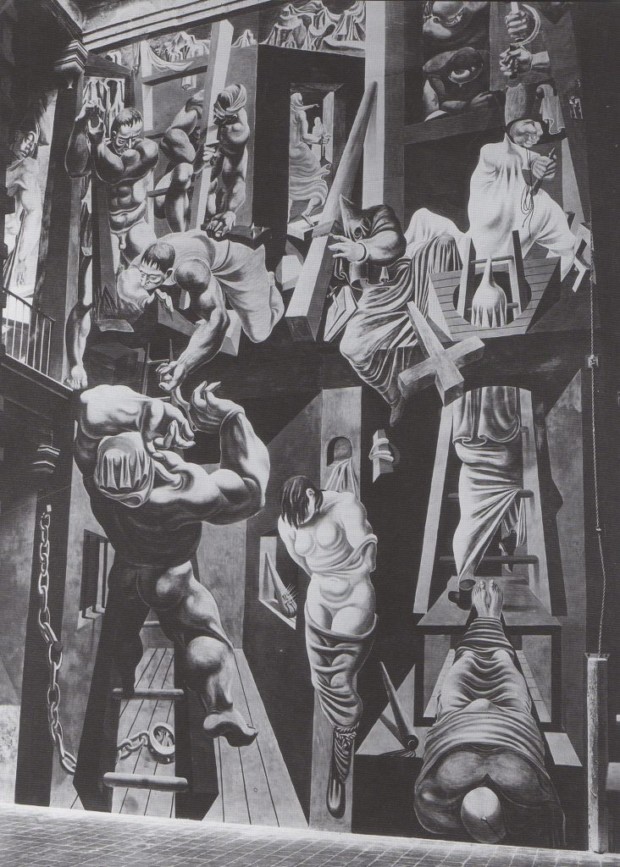















































Guston was horrified by the reports of the fascist bombing and the work he produced recalled the Renaissance style through the use of the tondo (circular work of art) and the color palette of reds and greens:
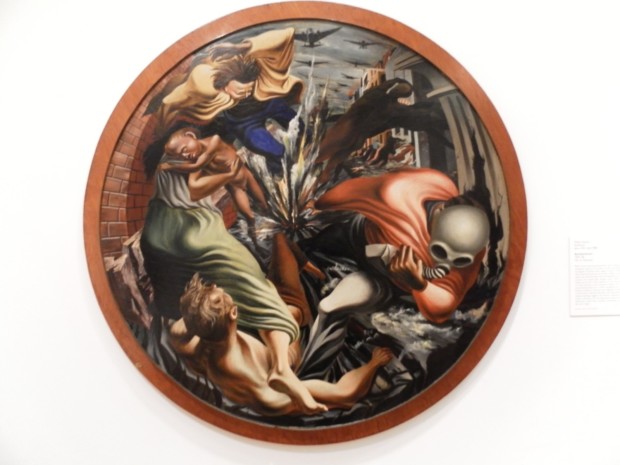
This painting, to be found at the Philadelphia Museum of Art is entitled Bombardment. The bombers deliver their deadly cargo centrally in the painting. The resulting explosion propels people and debris toward the viewer at an enormous speed. From the impact of the bomb, a charred figure is thrown sideways; his shadowy figure is ghost-like. At the top of the circle, a man, with flailing arms is sent skywards with nothing to stop his movement. As in Picasso’s work, Guston depicts a mother, dressed in green, unable to protect her naked infant from the explosion. She holds him in the pose of the Madonna.
At the bottom, a partially naked man lies in a pose that is reminiscent of Caravaggio’s depiction of the crucifixion of St Peter.
















































The figure clad in a red cloak, face covered with a gas mask completes the scene. Nothing was going to save these people from the atrocity, not the protection of the bricked tunnel they are in, the corrugated iron to the right, or the gas mask itself from the cavalcade of planes overhead.
Although not as famous as Picasso’s anti-war declaration, Guston’s view of Guernica is as powerful a statement as an artist can make in a bid to bring awareness and commemoration to a tragic event.
Supported by renowned cultural institutions in Europe and the United States, the Picasso Celebration 1973-2023 program is structured around over 50 exhibitions and events to be held at renowned cultural institutions in Europe and North America. As a whole, the events aim to present a historiographical approach to Picasso’s work.
The program offers an opportunity to assess the current state of research and understanding of Picasso’s work. Through a series of symposiums, the first being at the Museo Nacional Centro de Arte Reina Sofía in Madrid, followed by a significant international symposium on December 6-7-8, 2023 at Unesco in Paris, the legacy of the artist will be further explored. The latter symposium will bring together various stakeholders including museum institutions, research centers, and researchers under the theme “Picasso in the 21st Century: Historical and Cultural Issues.”
DailyArt Magazine needs your support. Every contribution, however big or small, is very valuable for our future. Thanks to it, we will be able to sustain and grow the Magazine. Thank you for your help!